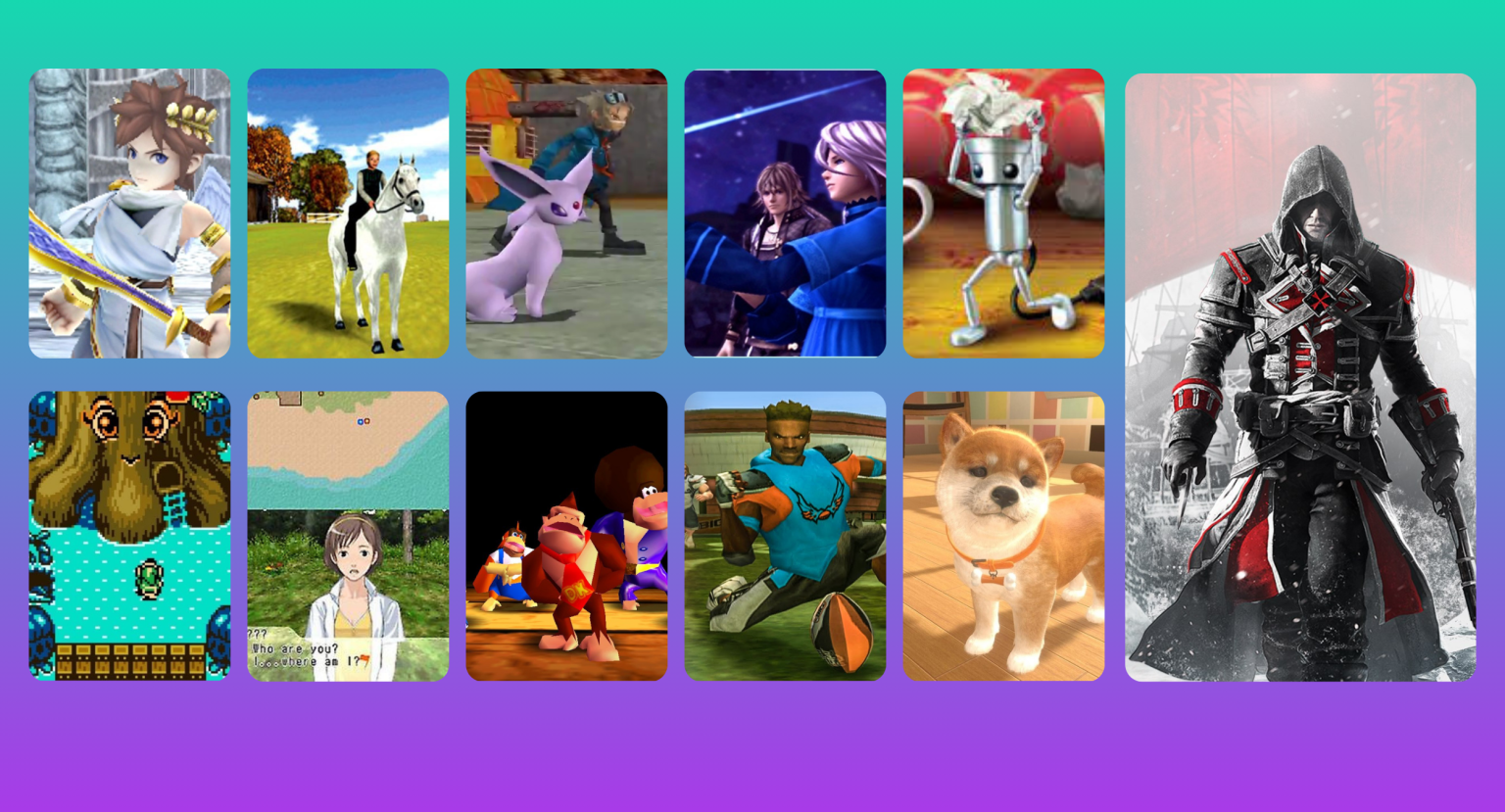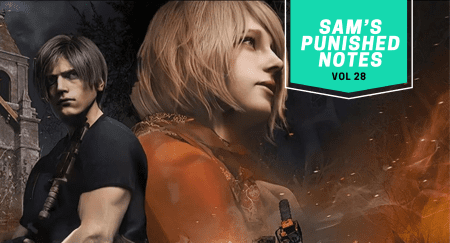2023 was a hell of a year for big new releases, but 2024 might be another big year… for remakes. Between Persona 3 Reload, Mario vs. Donkey Kong, Final Fantasy VII Rebirth, Paper Mario: The Thousand-Year Door, and Brothers: A Tale of Two Sons, this year seems like it’ll be an excellent year to try out refreshed (or reimagined) versions of some of the finest games of the past. In anticipation of such exciting remakes, our team has put together a list of games we believe deserve the remake treatment.
– Sam Martinelli, Editor
11 Video Games That Deserve Remakes
The following games are listed in alphabetical order. You can read on, or skip ahead to a certain entry:
- Assassin’s Creed Rogue
- Chibi-Robo
- Donkey Kong 64
- Kid Icarus: Uprising
- The Last Story
- The Legend of Zelda: Oracle of Ages & Seasons
- Let’s Ride!
- Lost in Blue
- NFL Street
- Nintendogs
- Pokémon Colosseum

Assassin’s Creed Rogue (2014)
More than anything else, Assassin’s Creed Rogue deserves a second chance, particularly with the opportunity to make its own mark in the series. Released for Xbox 360 and PlayStation 3 the same day as Assassin’s Creed Unity on the then-new Xbox One and PlayStation 4, Rogue—at least from an overall design perspective—largely existed to satiate Assassin’s Creed fans who hadn’t yet purchased a new $400 gaming box. It basically took 90% of the exact same game mechanics, graphical style, and even UI of 2013’s Assassin’s Creed IV: Black Flag and repurposed everything to fit with a new story and set of characters.
In terms of gameplay and feedback loop, Rogue is basically just a worse version of Black Flag (arguably the best game in the series). The combat is the same, the open-world sailing mechanics are largely the same, and even the basic ship upgrade system is the same. Moreover, Rogue is clearly an unpolished game, with more pop-in, glitches, and general jankiness than its predecessors. Simply put, Rogue felt in many ways like a lazy cash grab that Ubisoft could trot out knowing all the attention would really be on Unity.
At its core, though, Rogue has one of the best narratives of any game in the series, and explored an era of early American history that’s often forgotten. In Rogue, you play as Shay Patrick Cormac, a member of the Colonial Brotherhood of Assassins who defects to become a member of the Order of the Templars, the main antagonists of the whole franchise. As the game is set during the French and Indian War, Cormac travels through parts of what are now modern-day New York state (including Manhattan) and Southeast Canada in an effort to thwart the goals of his former colleagues. Through its setting, plot, and characters, the game explores themes of betrayal, the price of loyalty, and the sacrifices one may or may not be willing to make for “the greater good.” It’s a fascinating addition to the lore of the franchise and an interesting look at North America’s shaky existence before the Revolution.
Assassin’s Creed games are sort of “hit or miss” for me, and Rogue is by no means the best game in the series. Still, its compelling narrative and promising setting make for a worthwhile experience, and it could really stand out if given the love and care of a full-fledged entry in the franchise. I’d absolutely play it again if it received a complete remake with more of its own spice.
Platforms: Xbox 360, PlayStation 3, PC, Xbox One, PlayStation 4, Nintendo Switch
– Written by Sam Martinelli
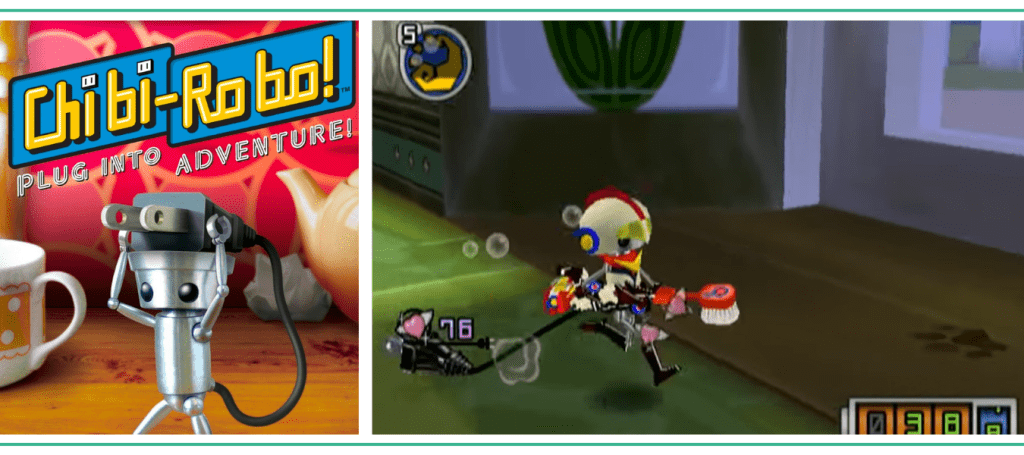
Chibi-Robo (2006)
Chibi-Robo, originally released on the Nintendo GameCube in 2006, desperately needs a remake before the series is lost forever! The adorable platformer is one of the most creative games I’ve ever played, and it was actually pretty well received at the time of its release (75 on Metacritic). What seemed like a budding new franchise with long-lasting potential has largely been forgotten, save for a few average spin-off titles on handheld consoles scattered over the last two decades. Chibi-Robo did briefly moonlight as a meme, created in the wake of this fiery tweet from Nintendo back in 2018, but unfortunately you can’t play a meme.
The original game feels a bit like a Toy Story fever dream, which I promise is a positive. You play as the titular Chibi-Robo, a tiny robot with a plug for a tail who has recently been purchased by Mr. Sanderson, an unemployed father of eight-year-old Jenny and husband to Helen. The game seems simple enough at first: Your job is to putter around the house, clean up after the family and help with domestic chores. You can pick up garbage, like candy wrappers and chip bags to make sure they’re disposed of properly. You can use a handy toothbrush to scrub floors and countertops to get them sparkly clean. And you can use a Mega Man-style blaster to destroy the evil robot Spydorz that roam the halls. You know, normal housework.
Of course, a game full of chores that you’re probably putting off in your own home may not sound like much fun, but that’s truly just the tip of the iceberg. Before you know it, you’re meeting a huge assortment of colorful (literally and figuratively) characters who have problems of their own that need to be solved, like action figure/TV star Drake Redcrest or the green-army-men-style Free Rangers, who are eggs-wearing soldier uniforms (obviously). The gameplay, puzzle solving, and story itself are all deceptively robust, and it’s the narrative specifically that has always impressed me most.
It doesn’t take long to figure out that a dirty home is the least of the problems facing the Sanderson family. The game tackles themes like divorce and trauma head-on, but in a way that fits into the story without bogging it down or feeling too heavy. The daughter, who dresses as, speaks like, and generally seems to believe she is a frog seems like a goofy bit of comic relief, but eventually it becomes clear that she is acting this way as a coping mechanism due to the turmoil in her parents’ relationship. It’s up to you not only to fix a home, but also a marriage and family as well. What can’t Chibi-Robo do?!
I haven’t even mentioned all the tiny details and impressive craftsmanship that I think truly take the game up another level. Just walking around the house and exploring is a sensory treat, as your tiny robot footsteps produce different sounds depending on the surface you’re traversing. A piano trickles as you run across the living room, while an accordion, does whatever accordions do during your time stomping over a blanket in the doghouse. Using the toothbrush to clean up messes introduces the strumming of a guitar and even the bleeps and bloops of the menu sound completely unique and fresh.
It may be this attention to the finer points of the game that has me most disappointed Chibi-Robo isn’t getting the recognition it deserves. The game was so clearly made with intense love and care, and it truly needs another shot at getting into the spotlight.
Please give it a second chance, Nintendo! Do it for the (frog) children!
Platform: Nintendo GameCube
– Written by Zack Gulinello
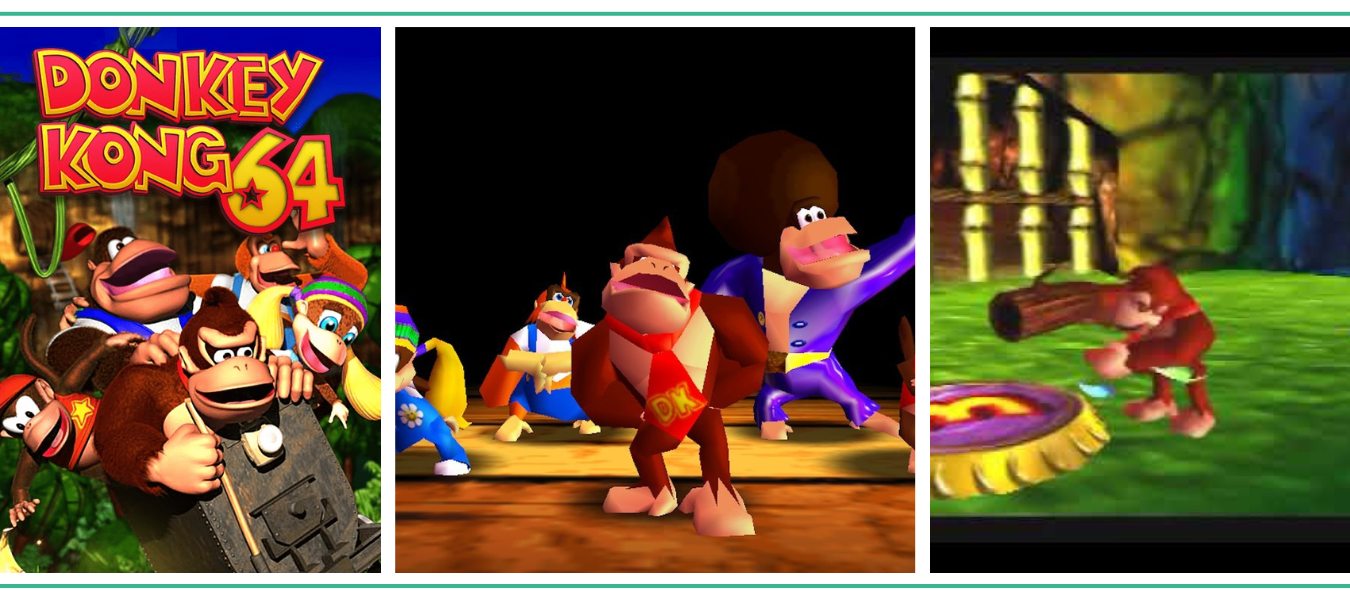
Donkey Kong 64 (1999)
No single development studio has had quite the impact on my video game upbringing that Rare did in the 90s. Donkey Kong Country, Banjo-Kazooie, Perfect Dark, and Goldeneye 007 helped shape the way I look at game design, as did one of their more bizarre Nintendo 64 titles: Donkey Kong 64, a game that simultaneously exists as one of its console’s brightest achievements and clunkiest messes.
Much like Banjo-Kazooie, DK64 is a 3D platformer where you go to a variety of themed worlds and collect a bunch of stuff that helps unlock more worlds. You can play as any of five different Kongs (Donkey, Diddy, Lanky, Tiny, and Chunky), each with their own unique abilities and challenges. I had a blast playing Donkey Kong 64’s single-player and multiplayer modes when I was a kid, and I’d love to experience all of it again.
So, why does this deserve a remake rather than a simple port or remaster? For one, it’s usually nice to refresh and refine the jankiness of early 3D games, especially ones that require precision and execution from the player. Moreover, DK64’s collectathon system is especially tedious, as each character has their OWN set of unique collectibles scattered throughout each world, so you have to comb through every single corner of every level with each character if you want to get anywhere near completion.
Still, despite these frustrations, Donkey Kong 64 is a tremendous game at its core. The different Kongs are vivacious and lovable, the original soundtrack from the legendary Grant Kirkhope contains the right mixture of bright optimism and somber creepiness, and the variety of level design really pops. DK64, if nothing else, deserves a “do-over,” where the vibes and concepts remain but some of the mechanical nitty-gritty gets an upgrade.
Platform: Nintendo 64
– Written by Sam Martinelli

Kid Icarus: Uprising (2012)
Among the pile of platformers on the NES, the original Kid Icarus (1986) had a unique take on the genre as a mythology-driven journey with some extra progression sprinkled on top. It got a sequel a few years later on the Game Boy, but then the franchise entered a 21-year hiatus. While obviously not the face of their best-selling games, Kid Icarus protagonist Pit was included on the roster for Super Smash Bros. Brawl (2008), joining the ranks of other unfortunate franchise faces like Earthbound’s Ness.
However, in 2012, this was no longer the case. Flying from the sky, Pit graced the Nintendo 3DS with Kid Icarus: Uprising, a shoot-em-up brawler made by the short-lived Project Sora that utilized the touch-screen for aiming. The angelic protagonist took on the armies of Medusa, just like in the NES platformer, but would also need to throw down with a surprise boss in Hades, the true ruler of the Underworld.
There are nine weapons, from the melee-centric and fast Claws to the slow but nuclear Cannon. Each of them changes Pit’s playstyle significantly in fights while relying on the same control schemes and mechanics. If that wasn’t enough, basically all weapons have massive differences between them thanks to the Fuse system, bringing Pit’s power level up slowly over the course of the game with different perks, flaws, and raw damage numbers. Fusing all of your best weapons into a single, powerful one—only to receive a middling Bow—was how I learned gambling was a problem as a youth.
Thankfully, all weapons are enjoyable to use in combat, and my young self learned how to appreciate all of them during the varied 25 chapters and multiplayer game modes. And that’s not even touching on the story. The voice actors for Palutena and Pit—Anthony Del Rio and Ali Hollis, respectively—inject each character with so much life. The villains are constantly interacting with the heroes, making for excellent dialogue scenes. And the game’s several twists, while not exactly heart-wrenching, create a world of intrigue, where few characters are actually pure evil.
The game was far from a perfect scorer, sadly; 83s don’t exactly make a brand-new franchise, and barely breaking 1 million copies within a year probably isn’t what Nintendo was looking for. This is a huge shame as the game is truly an imperfect masterpiece. Kid Icarus: Uprising‘s biggest problem was a bad control scheme, which could very easily be fixed on the Switch. The poor pacing in the midgame could also get smoothed over, and the fusion system could become more clear.
One more chance is all our plucky angel needs to be remembered as more than a mid-tier Smash Bros. fighter. Even Captain Falcon had more chances than he did.
Platform: Nintendo 3DS
– Written by Jason Toro
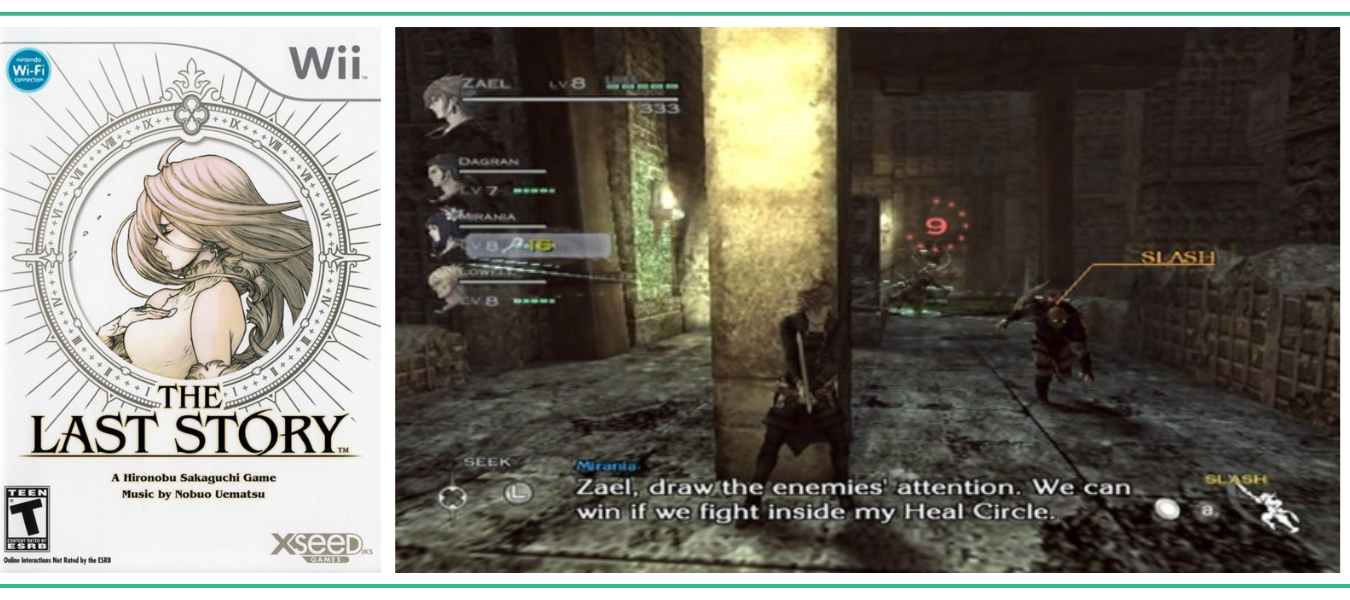
The Last Story (2011)
If we’re being upfront, I’ve been pretty blessed by the games industry’s choice in remasters and remakes these past few years. Nier (2010) was a game I was very high on at release despite middling review scores, and that game received a surprise sequel and then a remaster (Nier Replicant ver.1.22474487139…). Shadow of the Colossus is one of my favorite games of all time, and Bluepoint Studios did a masterful job remaking that game in 2018. Bluepoint then followed that up with Demon’s Souls, which I loved as a FromSoft fan. And Final Fantasy VII Remake and its planned sequels need no introduction.
When I think about remakes, I often think about games that showed clear promise, but were held back for whatever reason—performance and optimization (the case for a handful of Yoko Taro games, such as Nier and Drakengard 3), a graphical style unsuited for the platform in question, or games that were simply ahead of their time. The Last Story ticks all three boxes.
The Last Story was one of three games that was part of a fan movement known as Operation Rainfall. Operation Rainfall’s goal was to convince Nintendo to release three games that came out late in the Wii’s lifecycle, which were initially only going to be released in Japan and Europe, to also be released in North America in other regions. Xenoblade Chronicles is the most famous game out of that trio, but one of those other games was The Last Story.
The Last Story was a gem of an RPG with an interesting wrinkle to its combat system that incorporated specific elements of aggro, AI team member management, Area of Effect spell placement, and destructible environments in a manner almost reminiscent of coordinated MMO raids. It even included a significant multiplayer component, with co-op and PvP modes. The last game released on Wii to be directed by RPG legend Hironobu Sakaguchi, it also featured a soundtrack by the incredible Nobuo Uematsu (Final Fantasy, Chrono Trigger, Lost Odyssey).
Unfortunately, the game was also marred by performance issues, as well as a dour and realistic graphical style at odds with the Wii’s place in the console power hierarchy. The Last Story was also dinged for having a somewhat formulaic story despite well-written character interactions (which I can’t disagree with).
But what was corny and cringey then is nostalgic and reflective now, and its story wouldn’t feel out of place next to games like Octopath Traveler. Given the 2D-HD renaissance of Square Enix’s JRPG outings of late, it seems like a game that would fit in better now than when it was released, when audiences seemed to be craving a sort of “post-modern” JRPG experience. The Last Story was a unique, non-franchise outing that experimented with the genre in some ways while staying true to its roots in others, and it’s a game I would love to see recreated in the context of modern video game development.
Platform: Nintendo Wii
– Written by Kei Isobe
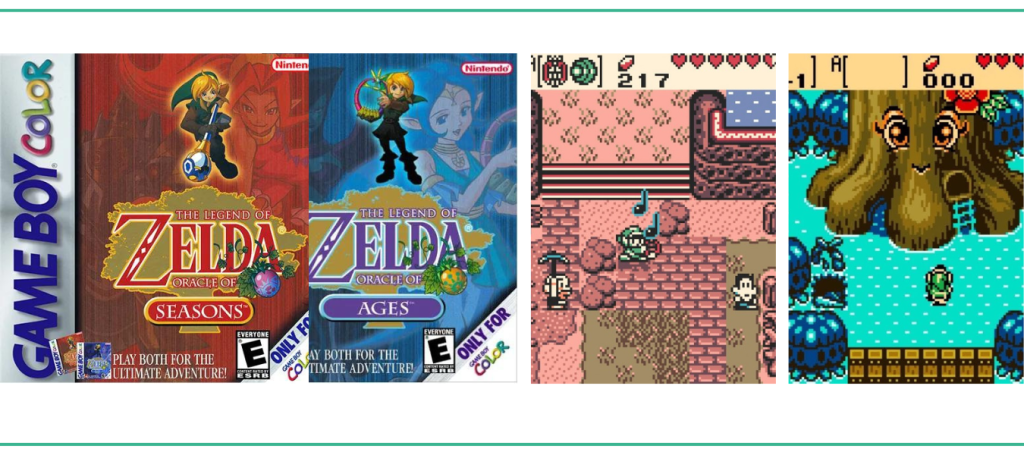
The Legend of Zelda: Oracle of Ages & Seasons (2001)
It’s tough to complain about Nintendo’s remake output as of late. Between 2019’s Link’s Awakening, last year’s Super Mario RPG, and upcoming refreshes of Paper Mario: The Thousand-Year Door, it’s a great time to revisit old classics.
And yet, I’m greedy. As much as I’ve enjoyed the Zelda remake treatment over the years—Majora’s Mask 3D has become my de facto way to experience that game—there will forever be injustice in the world of Hyrule until we see two oldies get their due. I’m talking about the vastly underrated, sorely under-appreciated, forever-fantastic Oracle of Ages and Seasons duology.
If you never got the chance to experience these masterpieces, allow me to sell you. Picture a Zelda experience that takes the pixel-perfect gameplay of Link’s Awakening DX and combines it with superior dungeons and catchier music. Now imagine that experience as two parallel games—a la Pokémon—that complement one another while offering wholly unique experiences.
That, dear reader, is what Ages and Seasons have to offer. If you don’t believe me—and you have access to Nintendo Switch Online Plus—you can try both games in their idyllic natural forms via emulation. They’re awesome.
That’s not to say they’re perfect. For all their strengths, Ages and Seasons suffer from the typical old-school Zelda tedium—namely, glacial backtracking and clunky item management. A remake could take advantage of the same engine Grezzo used to develop Link’s Awakening for Switch and provide some welcome quality-of-life improvements.
Sell ‘em separately for $60/$70 a piece, or bundle them together at a discount for diehard fans like myself. I don’t care how you do it, Nintendo, just as long as you do it.
Platforms: Game Boy Color, Nintendo Switch (via Nintendo Switch Online)
– Written by David Silbert

Let’s Ride! The Rosemond Hill Collection (2001)
When I look at “games for girls” from the early 2000s, it feels like a glorious fever dream. There was a MyScene game that featured detailed fashion-design and RPG-friendship elements. Incredibly smart Nancy Drew titles let young women solve puzzles and save lives. Nintendogs (which Allison goes into detail on in this list) helped initiate a generation of femme gamers. Oh, and the horse games. So many horse games.
The Let’s Ride! series was one of the frontrunners of that era of horse games. Let’s Ride: The Rosemond Hill Collection is a great example. It had three games, one of which was a straightforward showjumping and racing collection (bog standard!), and the other included racing along with a detailed stable simulator that included caregiving, breeding (which included complex matrices of stats and characteristics), training, and befriending. And on top of all of that, an actual plot! And then, against all logic, those games were bundled with a dark urban mystery.
When I realized there was a bonus disc called The Diamond Mystery, I was ecstatic. I was just starting to get into mystery games, and I was hungry for anything that let me feel like I was making a positive difference in the world on the hunt for truth. It was a better-than-average point-and-click mystery for the day, but more than anything, it is still just so weird to me that it shipped with these two pretty normal horse games.*
I would love to talk to someone who worked on this collection. The Diamond Mystery of Rosemond Valley makes absolutely no sense for why it was bundled with these bright, colorful horse games. The story featured kidnapping, affairs, lying, questions of journalistic integrity, and light elder fraud, amongst other things. I assume the game was made and the studio didn’t know how to sell it, so they just tucked it in case any weird kids (like me) got tired of the 90s obsession with marketing horses to girls. That being said, I do still want a good horse game.
Every now and then, I go on binges looking for modern “girl games” on the Nintendo eShop, and there really just aren’t a lot of quality examples. It’s good that we’ve moved away from overly gendered titles since the early 2000s, but the inverse problem is that, in a movement for “x is for everyone,” many gamers’ interests have been forgotten. The fashion games and horse games that have been available for the past 10-15 years suck. I know it’s bad when I searched for “current best horse games” and lists from sits like the excellent The Mane Quest blog frequently feature Red Dead Redemption 2 with a sort of half-hearted shrug.
I’d argue that the rise of cozy games and wholesome games showcases the void where many players and developers have felt their interests ignored. I was never a girly girl, and I often felt I didn’t fit in with other girls. But I thought horses were cool, and that gave me an in with the “normal girls.” In that generation, youth were fed a near-constant drip feed of books and films that romanticized a vision of freedom and friendship with a horse. Let’s ride again, shall we?
Platform: Windows PC
* I’m not the only one who thinks so. When writing this blurb, I couldn’t remember the names of these games, and I was Googling frantically like a paranoid movie character who’s the only one that remembers the truths of an alternate reality. Eventually, in a forum, a husband described the journey of trying to find this game for his wife and there it was. Additionally, shout-out to a blogger, Full of Salt, for doing a hilarious playthrough and including screenshots which have awakened the dark corners of my memory.
– Written by Amanda Tien
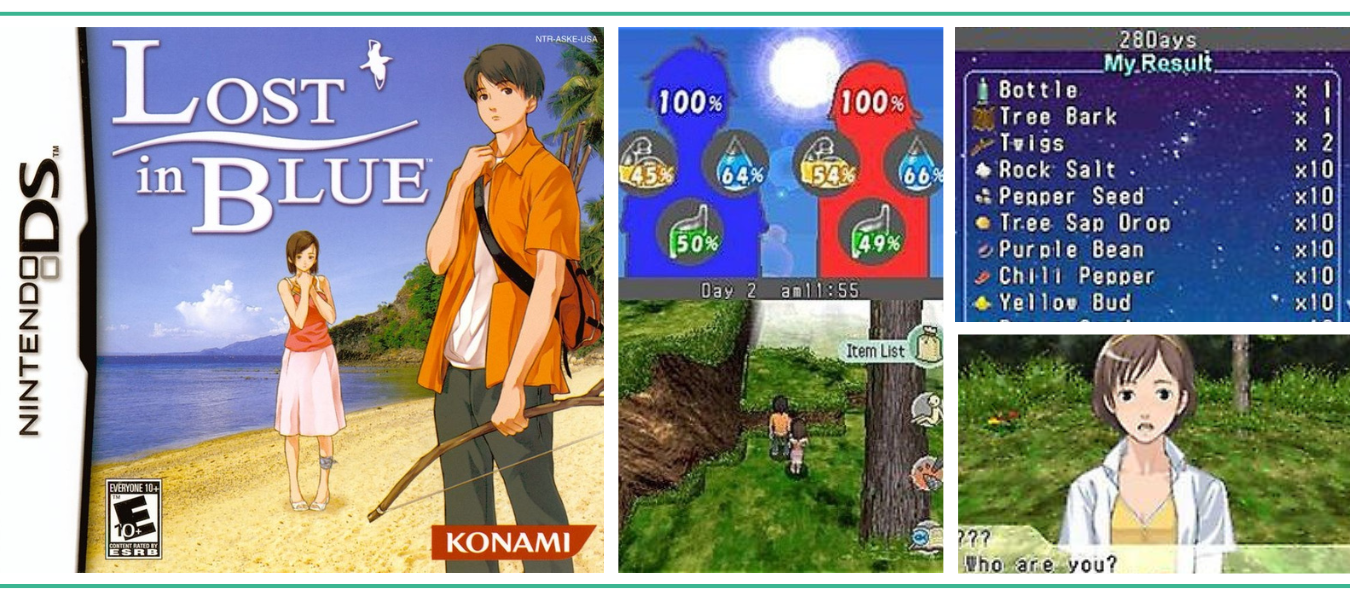
Lost in Blue (2005)
I loved my Nintendo DS (as we discussed on a podcast episode), and Lost in Blue (2005) and its 2007 sequel remain some of my all-time favorite games. (We don’t talk about Lost in Blue 3.) The survival simulators tasked players with gathering resources, managing two people’s health stats, upgrading a home base, and searching for a way off a deserted island. There were multiple ways to win, and many ways to lose. Starvation, dehydration, exhaustion, mauled by large cat, shot by evil environmental corporate agent, drowning, digesting a poisonous mushroom, etc.
Both games open with a teenage boy shipwrecked on a tropical island. He soon meets another survivor, a young woman, and they agree to team up in hopes of surviving. Lost in Blue and2 both made great use of the DS’ unique dual-screen structure to showcase a map at the same time as stats, or both characters’ faces during a tense conversation, or detailed views of fishing and cooking minigames that required fine-tuned movements. You also had to use the microphone to make a fire.
These games gave me a (surely unrealistic) confidence that I could survive if I were ever in the same situation. Each island unfurled before me, revealing new secrets and opportunities. There was an espionage subplot, a chaste romance arc, and complex puzzles. While it was stressful to fight a tiger hunting me, it was also cozy to build a treehouse base and domesticate local goats. The Lost in Blue games delivered hours of both adventure and contentment.
I would love to see Lost in Blue come back on the Nintendo Switch, at minimum as a port, but it’d also be amazing to see a full remake. The girl character always had less to do (the sequel at least gave the chance to play as her from the get-go), and it’d be nice to see a more equitable pairing. In an age where both wholesome games and top-down titles are having a renaissance (and the real world continues to be a nightmare), it’s a perfect chance to get lost in blue once again.
Platform: Nintendo DS
Note: If you google this, you’ll see it’s also listed on Android. This is a lie. That Lost in Blue is a very clear rip-off, also titled Lost in Blue, but with hyper-sexualized art, uber violence, zombie combat, and standard gacha mobile nonsense. I don’t want that.
– Written by Amanda Tien

NFL Street (2004)
Games, even ones from large publishers, used to be weirder. With profit margins cut, a lot of publishers decided to focus on what appealed to a much larger base. And when it came to the NFL licenses, those meant the simulation-focused approaches of Madden. While Madden has certainly been successful and popular, I still want my weird sports games.
NFL Street was exactly the type of weird I want. With a focus on big hits, zany moves, great soundtracks, and all the exciting players you know, the franchise danced the perfect line between fun sports action and buck-wild goofiness. What other games allow you to line Tom Brady up as a linebacker and lay a truck down on Lawyer Malloy, lined up as running-back? None, that’s who. Watching wide receiver Dwight Freeney sprinting with supercharged speed away from safety Donovan McNabb is a delight, and adding current players would level up the experience even more.
Another mark of a successful sports game is their ability to pick up and play. After all, you want to do these things with friends or online. Thanks to the less simulation nature of the Street games, they can be much more appealing to a casual audience, and help expand the reach of these titles. Remake or remaster them, put them out as a $40-$50 game, and you’ve got a stew going.
Really, I just want to line Patrick Mahomes up as a tight end and have Aaron Donald run through him. I’m a simple man.
Platforms: PlayStation 2, Xbox, GameCube, PlayStation Portable
– Written by Gary Wilson
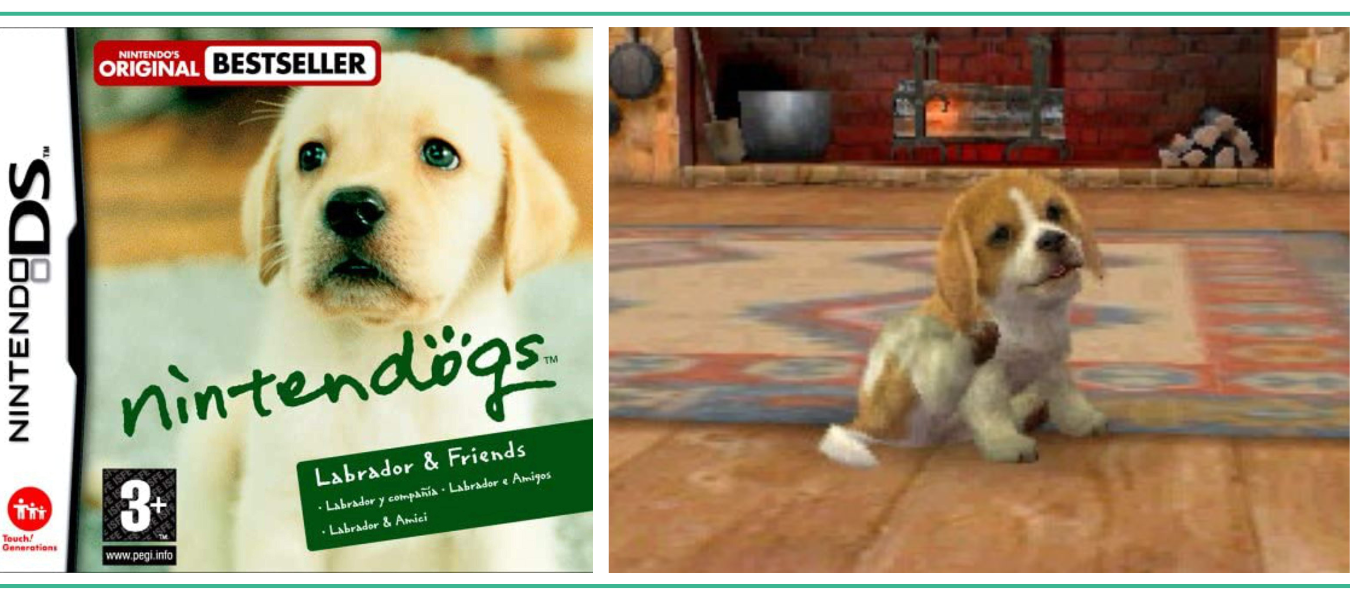
Nintendogs (2005)
Released in the mid-2000s, Nintendogs was a revolutionary Nintendo DS game for pet lovers. A series that lets you care for your virtual dogs in real time, Nintendogs came in multiple versions, each offering different breeds like Dalmatian, Chihuahua, or Shiba Inu. Players could pet their dog, feed it, play fetch, and even talk with it using the DS’s built-in microphone. Selling over 23 million copies, Nintendogs was a staple title for the nostalgic handheld device, with no game ever coming close to its charm since.
It’s a missed opportunity for Nintendo to not remake Nintendogs for the Switch. Recently, buzz has been generating about the game, as it’s been nearly 19 years since the first Nintendogs released on the DS. There was a sequel on the 3DS, Nintendogs + Cats in 2011, but the title didn’t quite live up to the hype of its predecessors. Especially as we gear up for a Switch successor, this could be the perfect time for Nintendo to remake a game that many remember and cherish from their childhood.
Platform: Nintendo DS
– Written by Allison McDaniel
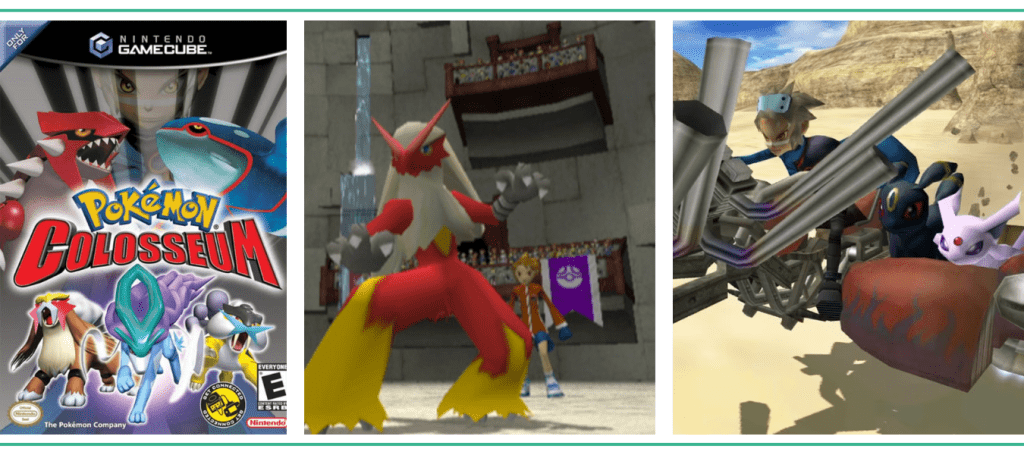
Pokémon Colosseum (2004)
Palworld has taken the world by storm—for all the right and wrong reasons. On the “wrong” side, the game is a clear case of marketing over matter. Take the creatures from Pokémon, the climbing mechanic from Zelda, the survival aspect of Ark, and the building of Fortnite—then throw it all into a blender—and you’ll make some headlines. Add guns for shock value, and it’s no wonder why the game sold over 12 million copies in a month.
At the same time, clearly the game did something right. As someone who’s been burned out on Pokémon for more than a decade, I’d be lying if I said the core loop of Palworld didn’t entice me. I’m not talking about the tree-chopping or the rocket-firing; I’m talking about the simple—and slightly edgy—fun of roaming a world and collecting a bunch of critters.
Pokémon Colosseum is the closest we ever got to that feeling. This 2004 title captured my imagination as a child, with its refreshing focus on story and world-building. No, it’s not an open world; in fact, the game is almost entirely linear. Instead, Pokémon Colosseum offered freedom through its tactical, 2v2 combat and (at the time) gorgeous 3D visuals.
Colosseum also offered some unique hooks. The game did away with the concept of fighting gym leaders and completing a Pokédex, instead tasking players with reclaiming Shadow Pokémon from an evil organization, “purifying” them, and enlisting their aid. With only about 60 creatures to collect, players had to be smart about the teams they assembled and move-sets they cultivated. The game was dark, moody, and surprisingly deep.
Is it the perfect analog to Palworld? No. If anything, as we discussed in our recent Pokémon episode of The Punished Podcast, Pokémon Legends: Arceus is closer from a sheer gameplay standpoint. But Pokémon Colosseum remains a sterling example of what Pokémon is capable of when it pushes the envelope. It’s a game that delivered style, substance, and heart—a cocktail Palworld could never concoct.
I have no clue whether or not Pokémon Colosseum still holds up. All I know is that I loved the game back then, and that it deserves a chance at a new audience today.
Platform: Nintendo GameCube
– Written by David Silbert
What Are Your Most Wanted Video Game Remakes?
Let us know in the comments!


